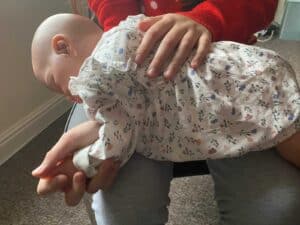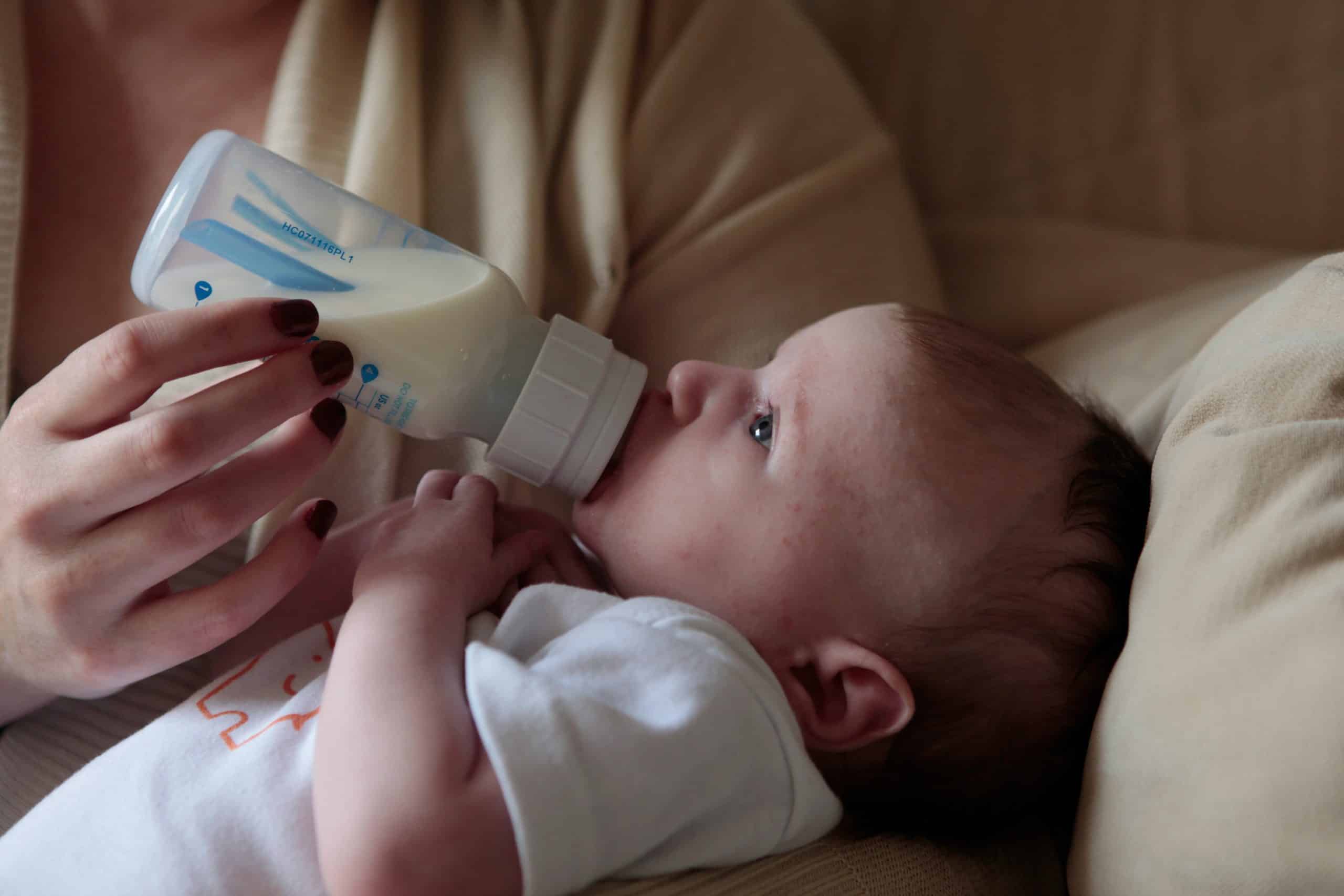There are lots of ways to wind your baby in various positions, but the two main positions that most people use are pictured and described below.
1.
2.
The first is by putting her up against your shoulder with her chest facing your chest (picture 1). Have one hand holding underneath her bottom to support her and use the other hand to pat and rub. The winding hand can also be used to support her head every now and then if she starts moving it around a lot and head-butting you.
As a guide, aim for 10 pats and 10 rubs. The pats should be aimed midway between the top of her shoulder blades and the middle of her back. Your pat needs to be quite firm to help the wind come up. Babies are very robust, even if they don’t look it, and you won’t hurt her with a firm pat!
Generally the burp tends to come out as you are rubbing, so it is very important to follow the rhythm of 10 pats and 10 rubs to help the wind come up. If you do too much of one or the other it will make a difference to the time you have to spend winding your baby.
Another way of winding a baby is to sit her on your lap facing outwards (picture 2). Place your hand quite firmly under her chin and try to have her back as straight as possible. If her body is all scrunched up and huddled over, you will find it very difficult to get the wind out, and she may even vomit as the milk she has just drank is being squashed in her tummy – in this instance the only way is up! Use your other hand to do the 10 pats, 10 rubs rhythm.
Winding a baby lying on her tummy (picture 3) can sometimes work too, but it is more likely to make your baby vomit if she is prone to doing that regularly anyway. I have also recorded a Youtube video which you can watch here.
I generally try the shoulder position first as I find it is a more comfortable position to wind a baby. If after five minutes like that I still haven’t heard a burp then I switch to the sitting position winding method. If you still haven’t heard a burp, and your baby continues to squirm, wriggle and look generally uncomfortable, then lie her down on the floor for a maximum of 60 seconds. If she really begins squirming and looking uncomfortable before the 60 seconds is up, then pick her up, put her over your shoulder and give her a little pat. This motion of lying a baby flat on their back is usually enough to make a burp come out when you pick them up again. You do have to get the timing right though because, if you leave her lying flat for too long and don’t pick her up quick enough, then she will vomit!
This is another learning curve where you will need to be guided by your baby. There will of course be a few times in the beginning where you don’t get the timing right and she covers you and her in vomit!
Some babies will burp very easily after every feed and never suffer with any type of wind-related pain. Others will make you work really hard to get a burp out of them, and, even when they produce a couple of loud ones, they may still seem very uncomfortable. Almost all babies are fairly easy to wind for the first one to two weeks. It is at this point, around the age of two weeks, that you will begin to notice if your baby is going to be one who struggles with digestive and wind-related problems.
To be honest it is a complete luck of the draw if you get a baby who winds easily, or one who is going to struggle to bring it up and be rather uncomfortable because of it for the next few months. This is also true with whether you get a baby who is a little bit sicky, a lot sicky or never vomits a drop up, even among siblings.
There are things you can do to help ease the pain of wind like changing feeding positions. There are also over-the-counter products, like Infacol that you can buy to help control and keep on top of the wind build up. There are also similar products called Dentinox and gripe water too, although gripe can only be given from one month, whereas the other two products can be given from birth.
Unfortunately, there is nothing that will give you a magic cure though. It is just something that you and your baby will have to try to work around until she gets older and her digestive system becomes stronger. As she grows her whole body stretches out more too so that she is not in that scrunched up foetal position all the time. This also makes it easier for her to burp and release wind.
Trumping or farting is also a form of releasing wind, so if your baby isn’t really a big burper, but has a lot of bottom wind and seems quite happy after a feed, then she is probably releasing it this way!
Having a very windy baby is totally different to having a baby with reflux or colic. Some people are too quick to jump to the conclusion that their baby has one of these, as opposed to just being a very windy baby. It will still be very painful at times and terribly uncomfortable for your baby if she suffers from bad wind, but be careful not to confuse the things.






